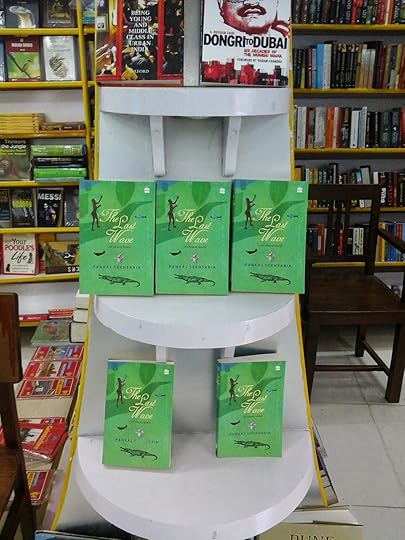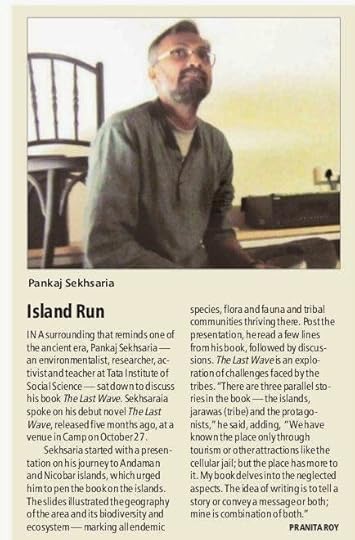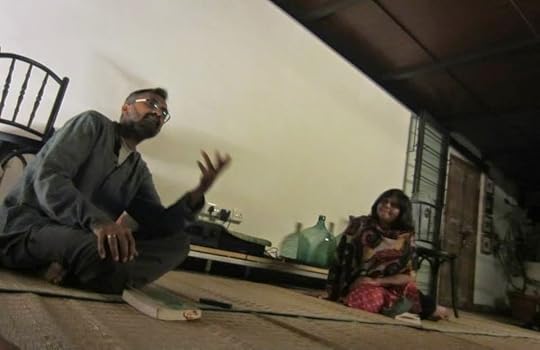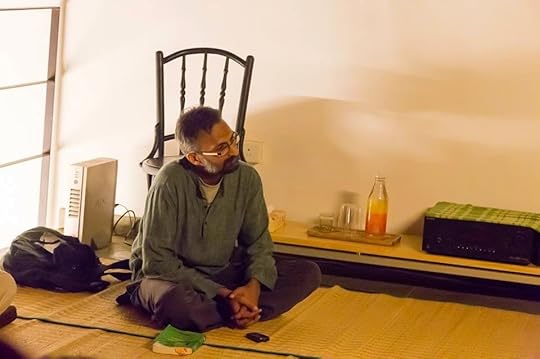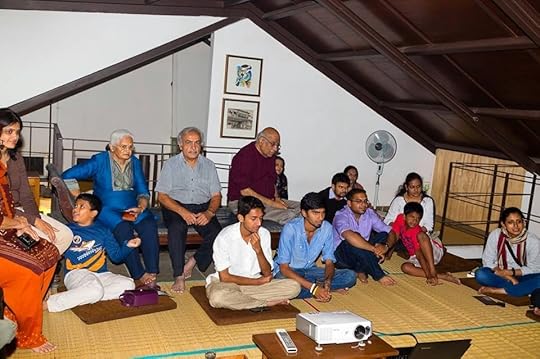Pankaj Sekhsaria's Blog, page 14
December 26, 2014
2008 hrs. Dec. 26, 2004: a post on andamanicobar@yahoogroups.co.in
Dec 26, 2004
2008 hrs
Hello everyone!
Another update. At the first place, thanks to RajSekhar and Mano Gupta
for being kind enough to call me up to pass on latest informations.
Just spoke to a friend in Androth Island, Lakshadweep. At 11.30 am tides
were 3.10 metres high (measured by Harbour department). When I called he
was standing right at the sea beach near their power station. The
population: 11,000 with most coconut cultivators. The coconuts were left
on the beach for drying. Guess what? Obviously, all swept away or
destroyed. They might have to face hard times now. But, casualties -
none (not offcial). Minicoy - not badly hit, but affected.
Andaman: Port Blair --- Two places majorly hit (as of inputs trickling
in from friends) - the coastal front facing Jawaharlal Nehru Rajkiya
MahaVidyalaya which is a popular tourist spot as well favourite spot for
locals to relax - smashed off ! Completely.
Junglighat in Port Blair is another coastal area and since I personally
have lived there for years together, do know that its a low-level area
and inputs indicate major damages. The worst part is my mother lives
right beside the Junglighat coast (one house behind immediate sea) and
no information still. All communication lines down.
Nicobar District: Car Nicobar - no news, no information - absolutely
nothing. Being strategically closer to the Sumatran islands and a
completely flat island, we just might need to cross our fingers and wait
for news. Unfortunately again, my father is based in Car Nicobar.
Hope all gets well.
Sharbendu De
2008 hrs
Hello everyone!
Another update. At the first place, thanks to RajSekhar and Mano Gupta
for being kind enough to call me up to pass on latest informations.
Just spoke to a friend in Androth Island, Lakshadweep. At 11.30 am tides
were 3.10 metres high (measured by Harbour department). When I called he
was standing right at the sea beach near their power station. The
population: 11,000 with most coconut cultivators. The coconuts were left
on the beach for drying. Guess what? Obviously, all swept away or
destroyed. They might have to face hard times now. But, casualties -
none (not offcial). Minicoy - not badly hit, but affected.
Andaman: Port Blair --- Two places majorly hit (as of inputs trickling
in from friends) - the coastal front facing Jawaharlal Nehru Rajkiya
MahaVidyalaya which is a popular tourist spot as well favourite spot for
locals to relax - smashed off ! Completely.
Junglighat in Port Blair is another coastal area and since I personally
have lived there for years together, do know that its a low-level area
and inputs indicate major damages. The worst part is my mother lives
right beside the Junglighat coast (one house behind immediate sea) and
no information still. All communication lines down.
Nicobar District: Car Nicobar - no news, no information - absolutely
nothing. Being strategically closer to the Sumatran islands and a
completely flat island, we just might need to cross our fingers and wait
for news. Unfortunately again, my father is based in Car Nicobar.
Hope all gets well.
Sharbendu De
Published on December 26, 2014 23:23
Revisiting the tsunami of Dec 2004: andamanicobar group
Dear Friends,
Today is, as we all know, the 10th anniversary of the earthquake and tsunami of December 2004, that influenced and changed the A&N islands like nothing we have known. As we remember what happened and take account of the changes, I thought it will be interesting to go back to the archives of the andamanicobar yahoogroup (that I have been moderating for over a decade) to see what happened here in the immediate aftermath of that event.
What I intend to do over the next few weeks is to re-post one (or perhaps) two posts from the e-group archive corresponding to that day exactly 20 years ago. I thought it will be a good way to remember and also to understand how things transpired and also to perhaps evaluate the value and relevance of this group itself. Before I do that however, I thought I'll also give a little history of the group that might be of interest. The group was started in October 2003 and had about 300 members in December 2004 when the tsunami struck. As would be expected interest in the islands surged and member of the group doubled to about 600 members in a months time. The number, of course, is small but that it doubled was of interest. The group has continued to be active since then with very important and relevant information being made available and rich and lively debates and discussions. The membership stands today at a little more than 1500 and this has roughly been the number for sometime now.
It is also interesting to note that the month of January 2005, the month immediately after the tsunami saw the maximum number of posts for a month on the group till date. That month we saw a total of 263 posts, a number that has not been surpassed yet for a monthly account though the membership has more than doubled.
-----------
Dec 26, 2004
1153 hrs
Dear Friends,
Below is the news item from the BBC on a major earthquake that hit South East Asia, earlier in the day. This news item does not mention the A&N at all, but there has been wide spread damage in the islands too. I am sending a separate mail with some initial information that we have gleaned from talking to friends in Port Blair.
Pankaj Sekhsaria
Tidal waves and tremors hit Asia
http://news.bbc.co.uk/1/hi/world/asia-pacific/4125481.stm
Significant casualties are being reported following tidal waves and earth tremors in countries across southern and eastern Asia. Large tidal waves striking coastal parts of Sri Lanka have reportedly killed at least 150 people.
Earlier, a massive earthquake, said to measure 8.5, hit Indonesia's Sumatra island at roughly 0800 local time. Earth tremors have also been reported in Bangladesh, while tourist resorts in Thailand have been hit by high tides. After the Indonesian quake, panicked people reportedly fled their homes in the towns of Medan and Banda Aceh, the capitals of two of Sumatra's provinces.
The US Geological Survey measured the quake at 8.5 magnitude. Indonesia's geological position - along the Pacific "Ring of Fire" - makes it prone to earthquakes and volcanoes. Electricity and telephone networks in the area have stopped working, making it difficult to confirm the extent of the damage, the BBC's Rachel Harvey in Jakarta reports.
Ground shaking
Indonesia's worst-hit region appears to be Aceh, a strife-torn province on Sumatra's northern-most tip which has seen heavy clashes between government soldiers and separatist rebels. Several houses in the towns of Banda Aceh and Lhokseumawe are said to have been damaged or washed away in flash floods.
A witness interviewed by a local radio station reported seeing nine bodies in Banda Aceh, where part of the town's largest hotel is said to have collapsed. "The ground was shaking for a long time," another witness told the radio station.The impact of the earthquake has been recorded as far afield as the Thai capital, Bangkok, and Singapore.
In November, 29 people died when an earthquake struck Indonesia's eastern province of Papua.
------
Dec 26, 2004
1155 hrs
Dear Friends,
Some initial information gleaned from friends in Port Blair indicates that there has been widespread damage caused in Port Blair because of the earthquake that hit about 6.30 IST. There reports of atleast two deaths as well. Many of the concrete, multistorey buildings in the city have developed cracks and at least one is said to have collapsed.
The Phoenix Bay jetty is also said to have gone half under water, as the city has been hit by tidal waves. Large parts of Port Blair are said to be without power and the telephone network has also been affected. Minor tremors were reported even as of about 11 am IST.
Car Nicobar, which is a rather flat island is supposed to have been badly hit, but there is no additional information. There is no news from Great Nicobar or the other Nicobar Islands which were even closer to the epicentre of the earthquake in Sumatra in Indonesia. Similarly there is yet no information from other parts of the Andamans such as North and Middle Andamans either.
Pankaj Sekhsaria
Today is, as we all know, the 10th anniversary of the earthquake and tsunami of December 2004, that influenced and changed the A&N islands like nothing we have known. As we remember what happened and take account of the changes, I thought it will be interesting to go back to the archives of the andamanicobar yahoogroup (that I have been moderating for over a decade) to see what happened here in the immediate aftermath of that event.
What I intend to do over the next few weeks is to re-post one (or perhaps) two posts from the e-group archive corresponding to that day exactly 20 years ago. I thought it will be a good way to remember and also to understand how things transpired and also to perhaps evaluate the value and relevance of this group itself. Before I do that however, I thought I'll also give a little history of the group that might be of interest. The group was started in October 2003 and had about 300 members in December 2004 when the tsunami struck. As would be expected interest in the islands surged and member of the group doubled to about 600 members in a months time. The number, of course, is small but that it doubled was of interest. The group has continued to be active since then with very important and relevant information being made available and rich and lively debates and discussions. The membership stands today at a little more than 1500 and this has roughly been the number for sometime now.
It is also interesting to note that the month of January 2005, the month immediately after the tsunami saw the maximum number of posts for a month on the group till date. That month we saw a total of 263 posts, a number that has not been surpassed yet for a monthly account though the membership has more than doubled.
-----------
Dec 26, 2004
1153 hrs
Dear Friends,
Below is the news item from the BBC on a major earthquake that hit South East Asia, earlier in the day. This news item does not mention the A&N at all, but there has been wide spread damage in the islands too. I am sending a separate mail with some initial information that we have gleaned from talking to friends in Port Blair.
Pankaj Sekhsaria
Tidal waves and tremors hit Asia
http://news.bbc.co.uk/1/hi/world/asia-pacific/4125481.stm
Significant casualties are being reported following tidal waves and earth tremors in countries across southern and eastern Asia. Large tidal waves striking coastal parts of Sri Lanka have reportedly killed at least 150 people.
Earlier, a massive earthquake, said to measure 8.5, hit Indonesia's Sumatra island at roughly 0800 local time. Earth tremors have also been reported in Bangladesh, while tourist resorts in Thailand have been hit by high tides. After the Indonesian quake, panicked people reportedly fled their homes in the towns of Medan and Banda Aceh, the capitals of two of Sumatra's provinces.
The US Geological Survey measured the quake at 8.5 magnitude. Indonesia's geological position - along the Pacific "Ring of Fire" - makes it prone to earthquakes and volcanoes. Electricity and telephone networks in the area have stopped working, making it difficult to confirm the extent of the damage, the BBC's Rachel Harvey in Jakarta reports.
Ground shaking
Indonesia's worst-hit region appears to be Aceh, a strife-torn province on Sumatra's northern-most tip which has seen heavy clashes between government soldiers and separatist rebels. Several houses in the towns of Banda Aceh and Lhokseumawe are said to have been damaged or washed away in flash floods.
A witness interviewed by a local radio station reported seeing nine bodies in Banda Aceh, where part of the town's largest hotel is said to have collapsed. "The ground was shaking for a long time," another witness told the radio station.The impact of the earthquake has been recorded as far afield as the Thai capital, Bangkok, and Singapore.
In November, 29 people died when an earthquake struck Indonesia's eastern province of Papua.
------
Dec 26, 2004
1155 hrs
Dear Friends,
Some initial information gleaned from friends in Port Blair indicates that there has been widespread damage caused in Port Blair because of the earthquake that hit about 6.30 IST. There reports of atleast two deaths as well. Many of the concrete, multistorey buildings in the city have developed cracks and at least one is said to have collapsed.
The Phoenix Bay jetty is also said to have gone half under water, as the city has been hit by tidal waves. Large parts of Port Blair are said to be without power and the telephone network has also been affected. Minor tremors were reported even as of about 11 am IST.
Car Nicobar, which is a rather flat island is supposed to have been badly hit, but there is no additional information. There is no news from Great Nicobar or the other Nicobar Islands which were even closer to the epicentre of the earthquake in Sumatra in Indonesia. Similarly there is yet no information from other parts of the Andamans such as North and Middle Andamans either.
Pankaj Sekhsaria
Published on December 26, 2014 06:18
November 29, 2014
A journey on the Andaman Trunk Road - The Last Wave
A Journey on the Andaman Trunk Road
An extract from 'The Last Wave - An Island Novel'
pg 228-230
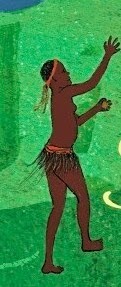 ...The bus groaned up a steep incline and then picked up speed as the road levelled out. They had been moving for about ten minutes when Seema noticed some movement among the trees just ahead. A young Jarawa woman with red cloth tied around her head and waist emerged from the roadside forest and started to run with the bus at its very front. The bus slowed down and the girl was now running alongside the driver. Seema pushed her head out through the railings of the window to see what was happening. Harish did the same and just about managed to catch the action. The Jarawa girl had stretched out her right hand towards the driver. A hand appeared from the bus and handed her a small packet. She transferred it to her left hand and stretched out her right hand once again. Another packet was passed on to her. Her hands dropped to her side and she moved away from the edge of the road, gazing intently at the shiny packets in her hand. It was a quick and efficient operation. The bus picked up speed again and left the Jarawa woman behind. It was evident from their shape, size and appearance that these were packets of paan masala and tobacco. ‘You saw that?’ Harish asked Seema, as they pulled their heads in.
...The bus groaned up a steep incline and then picked up speed as the road levelled out. They had been moving for about ten minutes when Seema noticed some movement among the trees just ahead. A young Jarawa woman with red cloth tied around her head and waist emerged from the roadside forest and started to run with the bus at its very front. The bus slowed down and the girl was now running alongside the driver. Seema pushed her head out through the railings of the window to see what was happening. Harish did the same and just about managed to catch the action. The Jarawa girl had stretched out her right hand towards the driver. A hand appeared from the bus and handed her a small packet. She transferred it to her left hand and stretched out her right hand once again. Another packet was passed on to her. Her hands dropped to her side and she moved away from the edge of the road, gazing intently at the shiny packets in her hand. It was a quick and efficient operation. The bus picked up speed again and left the Jarawa woman behind. It was evident from their shape, size and appearance that these were packets of paan masala and tobacco. ‘You saw that?’ Harish asked Seema, as they pulled their heads in. ‘Yes. This is crazy. The boards, the convoy, it’s all meaningless. Paan masala and tobacco to the Jarawas? It will ruin them.’
In a while, the entire convoy again did what it had been clearly instructed not to. It crossed a bridge over a gurgling stream of water and stopped as they negotiated a gentle bend. To be fair, they were forced to stop. They had finally caught up with the two tourist vehicles that had slipped ahead a short while ago. There was a big group of Jarawa here; the prime reason these visitors had undertaken this journey in the first place. The Jarawas had set up camp here only recently, attracted by a good combination of proximity to the road and access to a source of fresh water – the stream that the convoy had just crossed. This was the same group that Pintu had referred to and Justice Singh had also spoken about. All the occupants of the tourists vehicles were now out on the road, feverishly photographing the Jarawa and giving them the bananas and biscuits they had been carrying in the hope of this opportunity.
The look on Seema’s face was one of horror, and one that clearly indicated to Harish that something was about to happen.
‘What the hell is this?’ she fumed under her breath as she fumbled through the luggage-clogged passageway to the exit at the front of the bus. Harish followed. She headed straight for the policeman who sat unconcerned in the vehicle at the very front, chewing a mouthful of paan.
Seema stood glaring at the policeman, gritting her teeth, breathing fire. ‘What do you think you are doing?’ she shouted loud and angry, yanking the policeman out of his stupor. He looked up and down at Seema, stepped out from the vehicle, took a step forward and went ‘Thoo!’ The load in his mouth went flying through the air and created a dark, abstract stain as it hit the road with a splash.
‘Yes?’ he asked unconcerned, as Seema quickly took a small step back.
‘Chan . . . dra . . . shek . . . har Kumar,’ slowly and deliberately she read his name aloud from the badge on his chest. ‘How much money did these guys give you?’ She turned her contemptuous look at the driver of the vehicle. ‘Both of you are finished,’ she said with a bravado that had Harish biting his tongue.
He too was angry, but the absurdity of the situation made him want to laugh – this fuming young woman threatening a rifle- wielding, completely nonplussed policeman and a cowering driver who didn’t know what was hitting him. All the others had also realized that something was going on. They stopped what they were doing and turned towards where the action was now taking place.
‘Madam –’ the policeman began.
‘Shut up,’ she pounced on him furiously. ‘Listen,’ her finger was pointed accusingly at him, ‘I’ve got your name and these vehicle numbers. Just watch now.’
The impact was immediate and all those outside, the tourists, the photographers, even Chandrashekhar Kumar, quickly got back into their seats like little obedient children. Seema, however, was not done yet.
‘So, sir,’ her target now was the middle-aged, balding man who had taken his seat just behind Chandrashekhar Kumar. ‘Got good pictures of naked women?’ This wasn’t a question. ‘Big breasts? You like big breasts? You’ll frame it and put it alongside your wife’s picture, won’t you?’....
---
Get a copy of The Last Wave
Flipkart - http://t.co/n7RIVcl0pC
Amazon - http://tinyurl.com/leywz8c
Kindle - http://amzn.to/1uUq27n
Published on November 29, 2014 00:34
November 20, 2014
The Last Wave@The Earth Mela, Mumbai, Nov. 22
A presentation on the A&N Islands and The Last Wave in MumbaiAt the Earth Mela organised by Sprouts Environment Trust10.30 am, Nov. 22, Saturday at the Maharashtra Nature Park, Dharavi
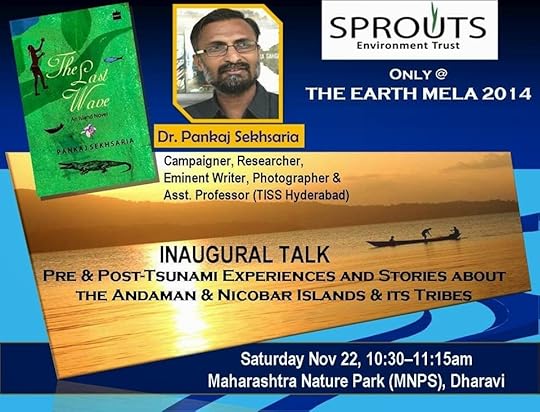

Published on November 20, 2014 06:38
November 15, 2014
Rediscovering Port Blair in 'The Last Wave - An island novel'
THE LAST WAVE - An Island Novel
Chapter 3Seema's Return
Pg 32-33An excerpt... ---
...Seema’s homecoming was, from the beginning, a mixed bag of discovery and loss: losing Ahmed Mia forever, but just after rediscovering him, and through him, new nooks and recesses, entire hidden passages of a lavishly rich history.
Delhi had been exciting but it could never be Port Blair. Delhi was a huge sprawl, soot-laden and suffocating, growing amoeba-like into land that extended infinitely on all sides. Port Blair was still small and compact, easily negotiable, eminently manageable, fresh and airy in a way that only small seaside towns can be. It urged you to breathe deeper and harder.
Seema knew its little paths and corners better than she knew the lines on her palms. The Mountbatten Cinema with its wooden pillars and old world charm; the saw mill at Chatham where she had become addicted to the smells of freshly sawn timber; Foreshore Road from where ships could be seen entering the harbour as if in a 70 mm wide-screen movie; the marine workshops at Phoenix Bay where history could be held in your hands (her most prized find there was a 1931 lantern from a dismantled ship of German origin); the view of Ross Island from atop Cellular Jail; Japanese World War II bunkers that stood all over like forgotten sentinels; Port Blair’s own Marine Drive that went on and on till it reached Corbyn’s Cove at the other end.
Homecomings allow an experience of change that is denied to those who never leave. Port Blair had changed significantly in the years Seema was away. It was like a little brat of a city now, discovering simultaneously the pains and the pleasures of growing up, forcing similar discoveries on those who cared for and lived with it; particularly for those who returned. It was far more crowded and chaotic than Seema remembered. There was an increasing restlessness – more vehicles, more speed, more movement, more action, more desire and greater ambition. The nights were longer, the shops bigger, the noises louder and the roads narrower. Garbage now accumulated on street corners and on the roads; dogs had multiplied in direct proportion to the spread of the dirt and filth (Port Blair had seen more cases of dog bites in the last three years than in the preceding thirty); previously unknown entities called beggars and pickpockets had begun plying their trade in the bazaar; street urchins now openly defecated in the overflowing British-era drains and traffic jams were a regular feature in Aberdeen Bazaar. Traffic snarls in Port Blair? Yes, all this and more in just a few years.
Old wooden Mountbatten Cinema was about to go and a steel and glass structure of a shopping mall was to come up in its place. The old wooden State Secretariat had gone too; everything was being replaced by monsters of the modern age, concrete replacing timber with a rapidity that would soon send termites out of business...
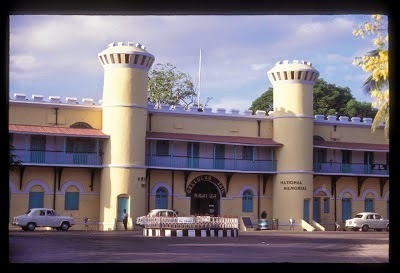 Cellular Jail, Port Blair
Cellular Jail, Port Blair----
Get a copy of The Last Wave
Flipkart - http://t.co/n7RIVcl0pC
Amazon - http://tinyurl.com/leywz8c
Kindle - http://amzn.to/1uUq27n
Published on November 15, 2014 08:47
November 9, 2014
'The Southernmost General Store of India' in The Last Wave - an island novel
THE LAST WAVE - An Island Novel
Chapter 22Nesting Turtles Pg 249-250----
MV Chowra docked at Campbell Bay, the administrative headquarters of Great Nicobar Island late on Christmas evening. The Range Forest Officer, Mr Das, was waiting for Harish and Seema at the jetty and they set off straightaway for the turtle camp at Galathea Bay forty kilometres away. The road hugged the coast for the most part, riding over muddy brown creeks, cutting through coconut plantations rich with large fruit, and past settlements with large houses made of timber and corrugated tin sheeting. Shastrinagar at the 35 kilometres mark was the last settlement along this road, and it was just as they passed the last house here that Das slowed his vehicle, pulled aside and stopped by a small shop with a huge areca plantation behind it. Potatoes, onions, biscuits packets, slippers, towels, coconuts, packets of grain and spices, all lay together in the few shelves on display in the front. The shop was dimly lit and rather empty otherwise. A kerosene stove buzzed incessantly outside and a small kettle hissed vapour in an unintended duet. The only exceptional feature of the shop was its name, which seemed to have been freshly painted on a big board by the roadside:
Southern Most General Store of India(6½°N Latitude)Shastrinagar, 35 kms, Great Nicobar Is.Proprietor – Balbir Singh
This was an accurate rendering of the shop’s geography; nothing indeed lay beyond Balbir Singh’s little entrepreneurial venture. Everyone who came here for the first time found this amusing and Seema smiled too as she saw the Board. For researchers going into the wilderness beyond, this was the last outpost of modern life.
Harish had been here a few months ago, and immediately recognised the old man sitting on a stool by the stove—the seventy-year-old proprietor with a long, flowing silver beard. He said a polite namaste, and sat down on the bench. The old man appeared to recognize Harish too, and returned his greeting with a pleasant smile.
‘Can we have some tea, Sardarji?’ Das called out from his vehicle, ‘and Harish,’ he continued, ‘please pick up the provisions that you want. You know you won’t get much at the camp. I think you should take some basic stuff—rice, dal, sugar, tea, pickle, some potatoes, onions and maybe...’ he scanned the shelves to see if he could find something interesting, ‘yes, take that tin of Haldiram’s rasogollas, but first check how old it is.’
Tea and shopping done, the visitors started off again. From here, the road went winding up a gentle gradient, then descended sharply and moved along the coast for a little before it cut more deeply into the forest. When it finally emerged, they found themselves at Galathea Bay. Here, at the mouth of the river Galathea, a wide beach of silver sand extended into the distance like a graceful arc of the waning moon. This was one of the best places to watch endangered sea turtles as they came out to nest.
The turtle camp of the Forest Department here was only a small bamboo shack, holed up in a small forest clearing by the beach. Camp Officer Winbrite Guria saluted Das, and said a big hello to Harish. He too had recognised Harish from his last visit. ‘If you need anything, tell Winbrite,’ Das said to Harish, and then turned to Winbrite, who had just unloaded the bags from the vehicle. ‘Ok, Winbrite? I’ll come back tomorrow afternoon.’
‘Yes, sir.’ Winbrite saluted again as Das returned to his vehicle.
The sun had retired for the night, and as was the practice here, the staff had already had their evening meal. Some dal and rice was now set to cook for the visitors. As they waited, Winbrite explained with an apology, ‘Hope you can manage somehow tonight. There is no sleeping place inside the hut, but first thing tomorrow morning we’ll organise something. Madam has come here for the first time, I’m really sorry.’
Harish had been here earlier and knew the forest staff quite well. He had been in these islands for only a little more than a year, but had already travelled quite widely and wildly, covering almost its entire length — from Landfall in the north of the Andamans to the Nicobars in the south, even into parts of the Jarawa Reserve that very few had visited. Improvising had become a way of life; be it shacking up in a police station in a remote village, spending a rainfilled night alongside cows in an abandoned bus shelter, being out at sea for over a week on a dungi or sleeping on the jetty because the evening boat had left ten minutes before schedule, he’d endured it all. Sleeping on a pristine beach like this one, with a starlit sky for a canopy was better than most other situations he’d encountered. He would be fine. He looked at Seema. She seemed pretty alright too.
‘We’ll be fine, Winbrite,’ Harish placed a hand on his shoulder. ‘Don’t worry.’
‘Yes, yes,’ Seema quickly added. ‘Don’t worry, Winbrite. I’ll be fine. I’m an island girl.’
It was about quarter past seven by the time the two had their simple meal for the night. Harish now unfurled a huge blue tarpaulin sheet and spread it out on the beach some distance from the turtle camp.
‘Hopefully,’ he said to Seema, ‘we’ll be beyond the high tide line and won’t have to run when the tide comes in. The tide’s beginning to rise, but it’s still a couple of hours from being full. That’s when the turtles will start to climb.’
A cool breeze had started to blow, setting Seema’s long hair aflutter. This was always a very pretty sight and Harish was lost for a moment. He was quickly brought back to the present, however, as the wind picked up speed and the tarpaulin started to flutter. ‘Help me,’ he called out to Seema, ‘before this damned thing flies away.’
They placed their haversacks on two corners and a couple of largish logs on the other edges, to hold down the blue sheet and then settled down on it themselves. It was Seema who broke the silence after a while. ‘You were so quiet, even contemplative, throughout the journey. Something on your mind? Is everything okay?’
‘Things are fine,’ Harish smiled and went quiet again.
Seema waited a while, hoping Harish would say something but there wasn’t a word. Finally, she cleared her throat deliberately, to gain his attention. ‘Harish, I,’ she paused, ‘I was wondering, if you got my letter?’
‘Letter? You wrote me a letter?’ he asked in a tone with genuine surprise.
‘Yes. Why are you surprised?’
‘No, I mean... yes. I got it. Of course I did.’
‘You did!’
‘Yes,’ Harish continued, ‘that postcard from Delhi with the dates of your arrival in Port Blair, and those too were wrong.’
‘Oh, that. Not the postcard... It was after that, a much longer letter.’ Seema paused and Harish waited for her to say something else. ‘Okay,’ she said dejectedly, ‘let it be then!’
‘Arre, what happened?’
‘No, Harish, it’s okay. I’ll just stroll along the beach for a while. You sleep now. Goodnight!’
She got up and walked away before he could say anything.
Harish was intrigued. ‘Seema’s written me a letter, and a long one? What could it have been? And why did she walk away like that? I’d better ask her tomorrow—don’t want so much hanging in the air,’ Harish thought as he sat staring at the sky and the ocean. In a while, he pulled out the mosquito net from his sack and tucked it under his head, zipped open his sleeping bag, snuggled in and closed his eyes. Seema, meanwhile, had reached the far end of the white sands. She stood here for a few minutes watching the waves before turning to walk back.
 Note: The 'real' Southernmost General Stores of India was swept away in the 2004 tsunami.
Note: The 'real' Southernmost General Stores of India was swept away in the 2004 tsunami.
---Get a copy of The Last Wave
Flipkart - http://t.co/n7RIVcl0pC
Amazon - http://tinyurl.com/leywz8c
Kindle - http://amzn.to/1uUq27n
Chapter 22Nesting Turtles Pg 249-250----
MV Chowra docked at Campbell Bay, the administrative headquarters of Great Nicobar Island late on Christmas evening. The Range Forest Officer, Mr Das, was waiting for Harish and Seema at the jetty and they set off straightaway for the turtle camp at Galathea Bay forty kilometres away. The road hugged the coast for the most part, riding over muddy brown creeks, cutting through coconut plantations rich with large fruit, and past settlements with large houses made of timber and corrugated tin sheeting. Shastrinagar at the 35 kilometres mark was the last settlement along this road, and it was just as they passed the last house here that Das slowed his vehicle, pulled aside and stopped by a small shop with a huge areca plantation behind it. Potatoes, onions, biscuits packets, slippers, towels, coconuts, packets of grain and spices, all lay together in the few shelves on display in the front. The shop was dimly lit and rather empty otherwise. A kerosene stove buzzed incessantly outside and a small kettle hissed vapour in an unintended duet. The only exceptional feature of the shop was its name, which seemed to have been freshly painted on a big board by the roadside:
Southern Most General Store of India(6½°N Latitude)Shastrinagar, 35 kms, Great Nicobar Is.Proprietor – Balbir Singh
This was an accurate rendering of the shop’s geography; nothing indeed lay beyond Balbir Singh’s little entrepreneurial venture. Everyone who came here for the first time found this amusing and Seema smiled too as she saw the Board. For researchers going into the wilderness beyond, this was the last outpost of modern life.
Harish had been here a few months ago, and immediately recognised the old man sitting on a stool by the stove—the seventy-year-old proprietor with a long, flowing silver beard. He said a polite namaste, and sat down on the bench. The old man appeared to recognize Harish too, and returned his greeting with a pleasant smile.
‘Can we have some tea, Sardarji?’ Das called out from his vehicle, ‘and Harish,’ he continued, ‘please pick up the provisions that you want. You know you won’t get much at the camp. I think you should take some basic stuff—rice, dal, sugar, tea, pickle, some potatoes, onions and maybe...’ he scanned the shelves to see if he could find something interesting, ‘yes, take that tin of Haldiram’s rasogollas, but first check how old it is.’
Tea and shopping done, the visitors started off again. From here, the road went winding up a gentle gradient, then descended sharply and moved along the coast for a little before it cut more deeply into the forest. When it finally emerged, they found themselves at Galathea Bay. Here, at the mouth of the river Galathea, a wide beach of silver sand extended into the distance like a graceful arc of the waning moon. This was one of the best places to watch endangered sea turtles as they came out to nest.
The turtle camp of the Forest Department here was only a small bamboo shack, holed up in a small forest clearing by the beach. Camp Officer Winbrite Guria saluted Das, and said a big hello to Harish. He too had recognised Harish from his last visit. ‘If you need anything, tell Winbrite,’ Das said to Harish, and then turned to Winbrite, who had just unloaded the bags from the vehicle. ‘Ok, Winbrite? I’ll come back tomorrow afternoon.’
‘Yes, sir.’ Winbrite saluted again as Das returned to his vehicle.
The sun had retired for the night, and as was the practice here, the staff had already had their evening meal. Some dal and rice was now set to cook for the visitors. As they waited, Winbrite explained with an apology, ‘Hope you can manage somehow tonight. There is no sleeping place inside the hut, but first thing tomorrow morning we’ll organise something. Madam has come here for the first time, I’m really sorry.’
Harish had been here earlier and knew the forest staff quite well. He had been in these islands for only a little more than a year, but had already travelled quite widely and wildly, covering almost its entire length — from Landfall in the north of the Andamans to the Nicobars in the south, even into parts of the Jarawa Reserve that very few had visited. Improvising had become a way of life; be it shacking up in a police station in a remote village, spending a rainfilled night alongside cows in an abandoned bus shelter, being out at sea for over a week on a dungi or sleeping on the jetty because the evening boat had left ten minutes before schedule, he’d endured it all. Sleeping on a pristine beach like this one, with a starlit sky for a canopy was better than most other situations he’d encountered. He would be fine. He looked at Seema. She seemed pretty alright too.
‘We’ll be fine, Winbrite,’ Harish placed a hand on his shoulder. ‘Don’t worry.’
‘Yes, yes,’ Seema quickly added. ‘Don’t worry, Winbrite. I’ll be fine. I’m an island girl.’
It was about quarter past seven by the time the two had their simple meal for the night. Harish now unfurled a huge blue tarpaulin sheet and spread it out on the beach some distance from the turtle camp.
‘Hopefully,’ he said to Seema, ‘we’ll be beyond the high tide line and won’t have to run when the tide comes in. The tide’s beginning to rise, but it’s still a couple of hours from being full. That’s when the turtles will start to climb.’
A cool breeze had started to blow, setting Seema’s long hair aflutter. This was always a very pretty sight and Harish was lost for a moment. He was quickly brought back to the present, however, as the wind picked up speed and the tarpaulin started to flutter. ‘Help me,’ he called out to Seema, ‘before this damned thing flies away.’
They placed their haversacks on two corners and a couple of largish logs on the other edges, to hold down the blue sheet and then settled down on it themselves. It was Seema who broke the silence after a while. ‘You were so quiet, even contemplative, throughout the journey. Something on your mind? Is everything okay?’
‘Things are fine,’ Harish smiled and went quiet again.
Seema waited a while, hoping Harish would say something but there wasn’t a word. Finally, she cleared her throat deliberately, to gain his attention. ‘Harish, I,’ she paused, ‘I was wondering, if you got my letter?’
‘Letter? You wrote me a letter?’ he asked in a tone with genuine surprise.
‘Yes. Why are you surprised?’
‘No, I mean... yes. I got it. Of course I did.’
‘You did!’
‘Yes,’ Harish continued, ‘that postcard from Delhi with the dates of your arrival in Port Blair, and those too were wrong.’
‘Oh, that. Not the postcard... It was after that, a much longer letter.’ Seema paused and Harish waited for her to say something else. ‘Okay,’ she said dejectedly, ‘let it be then!’
‘Arre, what happened?’
‘No, Harish, it’s okay. I’ll just stroll along the beach for a while. You sleep now. Goodnight!’
She got up and walked away before he could say anything.
Harish was intrigued. ‘Seema’s written me a letter, and a long one? What could it have been? And why did she walk away like that? I’d better ask her tomorrow—don’t want so much hanging in the air,’ Harish thought as he sat staring at the sky and the ocean. In a while, he pulled out the mosquito net from his sack and tucked it under his head, zipped open his sleeping bag, snuggled in and closed his eyes. Seema, meanwhile, had reached the far end of the white sands. She stood here for a few minutes watching the waves before turning to walk back.
 Note: The 'real' Southernmost General Stores of India was swept away in the 2004 tsunami.
Note: The 'real' Southernmost General Stores of India was swept away in the 2004 tsunami.---Get a copy of The Last Wave
Flipkart - http://t.co/n7RIVcl0pC
Amazon - http://tinyurl.com/leywz8c
Kindle - http://amzn.to/1uUq27n
Published on November 09, 2014 22:53
The Last Wave@Popular Book House, Pune
Published on November 09, 2014 05:27
November 1, 2014
The Giant Leatherback in 'The Last Wave - an island novel'
THE LAST WAVE - an island novel
Chapter 22Nesting TurtlesPg 256-258
 ...‘Keep your distance or you’ll spook her,’ Harish whispered to Seema just as she was thinking of walking up to the animal. ‘This,’ he said, in a voice full of reverence and awe, ‘is what we came here for – the Giant Leatherback turtle, one of the greatest travellers of the world’s oceans, the gentlest giant if there ever was one and amongst the most vulnerable.’
...‘Keep your distance or you’ll spook her,’ Harish whispered to Seema just as she was thinking of walking up to the animal. ‘This,’ he said, in a voice full of reverence and awe, ‘is what we came here for – the Giant Leatherback turtle, one of the greatest travellers of the world’s oceans, the gentlest giant if there ever was one and amongst the most vulnerable.’

Seema watched intently as the turtle dragged herself a couple of feet and stopped for rest. She was panting heavily. With every bit of air she inhaled, the bottom of her neck swelled like a small balloon. She exhaled, an equally laborious process, and then inhaled again. Then her whole body, nearly 400 kilograms of marine muscle, shuddered as the front flippers came into action. She dragged her body a couple of feet more and then stopped again to rest. ‘What effort,’ Seema thought to herself. She remembered seeing on the National Geographic, just a couple of weeks ago, an underwater film on corals that had some significant turtle sequences as well. The camera had followed a green sea turtle gliding gracefully and effortlessly amidst the incredible shapes and colours of that beautiful coral garden. To now see another turtle struggling so on land was a jolt. The turtle, however, was here of her own volition, the immutability of her instinct, of the timeless process of evolution. She was here to lay her eggs, she had to undergo this labour – she had no choice.
Three quarters of an hour of laborious digging, now with her rear flippers, created a perfect excavation, a cylindrical hole about a foot and a half deep. She then positioned herself on top of the nest hole and readied herself. Harish shone the light of his torch into the nest as the eggs started to pop out in a continuous succession. Sparklingly white, perfectly spherical, a little smaller than a tennis ball. Coated in a sticky, slimy fluid, they fell slowly in ones and twos. Winbrite and his team had also arrived, careful to approach from behind and not anywhere in the line of sight of the huge creature. An error here and she’d be spooked; all the labour wasted as she followed her instinct and returned to the safety of the sea, her eggs unlaid.
The team were an experienced lot. As the eggs began to fall, one of them sprawled on the sand, stomach down. He stuck his hand into the nest and began to bring out the eggs. These were then carted away immediately to the fenced hatchery further up the beach, where they were laid back into pits similar to the one the turtle had excavated. This had to be done to protect the eggs from being poached, particularly by the feral dogs that had proliferated here in recent years. By the time the turtle had finished laying all her eggs – a total of 101 – Winbrite’s team had successfully carried all the eggs away, to a safer place.
Unaware of the benevolent designs of the people standing behind her, the turtle began the reverse process. Using her rear flippers, she began to pull sand back into the nest hole that should have held the eggs. The nest hole filled up in a few minutes and then she began her laborious crawl back towards the ocean, leaving her eggs to their fate. This is where the sea turtle was different from the crocodile. It was not in her code to be the protective, aggressive mother. She’d done the best she could, and the rest was to be left to nature and the elements.
So far, Seema had been completely engrossed in the activity of the turtle. She had taken notice of every flick of the flippers, every breath, every single groan that emitted from somewhere deep within the creature. Now, as the turtle headed back, Seema was overwhelmed. She stood for a moment, tilted her head up a little to look at the sparkling sky, opened her arms to embrace the heavens above and took a deep breath, then another, and yet another. On this remote beach of soft white sand, on this magnificent, mysterious night, she had just had a rare privilege. An ancient creature, the renewal of life, an extraordinary event; she was grateful to be alive.
‘Seema,’ Harish’s voice came wafting through the moist breeze, from the direction in which the turtle had just headed. ‘Come here quickly.’
She trotted across to a point just above the waterline, where the ocean waves thrashed tirelessly at the bottom of the beach. At the water’s edge here, the turtle had sensed that extra bit of moistness in the sand below her. This seemed to bring additional life into the tired body – very much the traveller who was now in sight of her destination. She waited for the next offering from home, another gently lapping wave that just about reached her neck. It was precisely the vitalizer she needed. There was extra energy in those tired flippers as she vigorously hauled herself down the final gentle slope. She’d covered a few feet by the time the next wave came in. Her pace quickened, aided perhaps by the fact that she was now on sand that had gone soft and gooey with the water that was churning underneath her. She was completely engulfed even as this wave withdrew, and was much deeper in the water by the time the next one came along. Harish and Seema walked as far as they could into the water, trying to keep pace with the turtle, holding hands to keep their own balance in the midst of the tireless waves. Finally, they could go no further. They stood silently, watching the retreating hump of the turtle’s wet back as it glistened in the white light of the soft moon. Then she was gone.
 The Giant Leatherback leaves behind her flipper marks as she returns to the ocean after nesting
The Giant Leatherback leaves behind her flipper marks as she returns to the ocean after nesting
----- Get a copy of the book:Flipkart - http://t.co/n7RIVcl0pC
Amazon - http://tinyurl.com/leywz8c
Kindle - http://amzn.to/1uUq27n
Chapter 22Nesting TurtlesPg 256-258
 ...‘Keep your distance or you’ll spook her,’ Harish whispered to Seema just as she was thinking of walking up to the animal. ‘This,’ he said, in a voice full of reverence and awe, ‘is what we came here for – the Giant Leatherback turtle, one of the greatest travellers of the world’s oceans, the gentlest giant if there ever was one and amongst the most vulnerable.’
...‘Keep your distance or you’ll spook her,’ Harish whispered to Seema just as she was thinking of walking up to the animal. ‘This,’ he said, in a voice full of reverence and awe, ‘is what we came here for – the Giant Leatherback turtle, one of the greatest travellers of the world’s oceans, the gentlest giant if there ever was one and amongst the most vulnerable.’

Seema watched intently as the turtle dragged herself a couple of feet and stopped for rest. She was panting heavily. With every bit of air she inhaled, the bottom of her neck swelled like a small balloon. She exhaled, an equally laborious process, and then inhaled again. Then her whole body, nearly 400 kilograms of marine muscle, shuddered as the front flippers came into action. She dragged her body a couple of feet more and then stopped again to rest. ‘What effort,’ Seema thought to herself. She remembered seeing on the National Geographic, just a couple of weeks ago, an underwater film on corals that had some significant turtle sequences as well. The camera had followed a green sea turtle gliding gracefully and effortlessly amidst the incredible shapes and colours of that beautiful coral garden. To now see another turtle struggling so on land was a jolt. The turtle, however, was here of her own volition, the immutability of her instinct, of the timeless process of evolution. She was here to lay her eggs, she had to undergo this labour – she had no choice.
Three quarters of an hour of laborious digging, now with her rear flippers, created a perfect excavation, a cylindrical hole about a foot and a half deep. She then positioned herself on top of the nest hole and readied herself. Harish shone the light of his torch into the nest as the eggs started to pop out in a continuous succession. Sparklingly white, perfectly spherical, a little smaller than a tennis ball. Coated in a sticky, slimy fluid, they fell slowly in ones and twos. Winbrite and his team had also arrived, careful to approach from behind and not anywhere in the line of sight of the huge creature. An error here and she’d be spooked; all the labour wasted as she followed her instinct and returned to the safety of the sea, her eggs unlaid.
The team were an experienced lot. As the eggs began to fall, one of them sprawled on the sand, stomach down. He stuck his hand into the nest and began to bring out the eggs. These were then carted away immediately to the fenced hatchery further up the beach, where they were laid back into pits similar to the one the turtle had excavated. This had to be done to protect the eggs from being poached, particularly by the feral dogs that had proliferated here in recent years. By the time the turtle had finished laying all her eggs – a total of 101 – Winbrite’s team had successfully carried all the eggs away, to a safer place.
Unaware of the benevolent designs of the people standing behind her, the turtle began the reverse process. Using her rear flippers, she began to pull sand back into the nest hole that should have held the eggs. The nest hole filled up in a few minutes and then she began her laborious crawl back towards the ocean, leaving her eggs to their fate. This is where the sea turtle was different from the crocodile. It was not in her code to be the protective, aggressive mother. She’d done the best she could, and the rest was to be left to nature and the elements.
So far, Seema had been completely engrossed in the activity of the turtle. She had taken notice of every flick of the flippers, every breath, every single groan that emitted from somewhere deep within the creature. Now, as the turtle headed back, Seema was overwhelmed. She stood for a moment, tilted her head up a little to look at the sparkling sky, opened her arms to embrace the heavens above and took a deep breath, then another, and yet another. On this remote beach of soft white sand, on this magnificent, mysterious night, she had just had a rare privilege. An ancient creature, the renewal of life, an extraordinary event; she was grateful to be alive.
‘Seema,’ Harish’s voice came wafting through the moist breeze, from the direction in which the turtle had just headed. ‘Come here quickly.’
She trotted across to a point just above the waterline, where the ocean waves thrashed tirelessly at the bottom of the beach. At the water’s edge here, the turtle had sensed that extra bit of moistness in the sand below her. This seemed to bring additional life into the tired body – very much the traveller who was now in sight of her destination. She waited for the next offering from home, another gently lapping wave that just about reached her neck. It was precisely the vitalizer she needed. There was extra energy in those tired flippers as she vigorously hauled herself down the final gentle slope. She’d covered a few feet by the time the next wave came in. Her pace quickened, aided perhaps by the fact that she was now on sand that had gone soft and gooey with the water that was churning underneath her. She was completely engulfed even as this wave withdrew, and was much deeper in the water by the time the next one came along. Harish and Seema walked as far as they could into the water, trying to keep pace with the turtle, holding hands to keep their own balance in the midst of the tireless waves. Finally, they could go no further. They stood silently, watching the retreating hump of the turtle’s wet back as it glistened in the white light of the soft moon. Then she was gone.
 The Giant Leatherback leaves behind her flipper marks as she returns to the ocean after nesting
The Giant Leatherback leaves behind her flipper marks as she returns to the ocean after nesting----- Get a copy of the book:Flipkart - http://t.co/n7RIVcl0pC
Amazon - http://tinyurl.com/leywz8c
Kindle - http://amzn.to/1uUq27n
Published on November 01, 2014 23:00
October 30, 2014
The Last Wave@The Loft, Pune, October 27, 2014
Published on October 30, 2014 00:21
October 26, 2014
Organic Jarawa: An episode in a novel about the Andamans comes eerily close to reality
Organic Jarawa: An episode in a novel about the Andamans comes eerily close to realityhttp://www.thenewsminute.com/lives/40...
The News Minute | October 26, 2014 | 10.54 am IST
The question of how two French filmmakers ventured into the Jarawa Reserve to make a film, has uncanny parallels with a novel about the Andamans published in May this year.
French filmmaker Alexandre Dereims has been in and out of the reserve for three years, filming within the reserve into which entry is restricted. Following news reports about the film first by Andamanchronicle.net editor Denis Giles, the local administration has lodged cases against the filmmakes and has also sent them a notice restraining the release of the film.
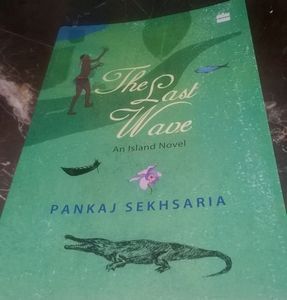 Read:
How did two French filmmakers enter restricted Jarawa territory, shoot a full-fledged movie?
Read:
How did two French filmmakers enter restricted Jarawa territory, shoot a full-fledged movie?
This incident, bears striking resemblance to one of the sub-plots in the novel The Last Wave, authored by journalist, researcher and photographer Pankaj Sekhsaria. Published in May, the novel is about the Andaman Islands and its people. The Jarawas are central to the novel. In an interview with The News Minute in August, Sekhsaria described his novel in these terms: “If you see in the novel, one never really enters the Jarawa forests. It’s a story about the fringes, about that interface (between the settlers and the Jarawas), the challenges that the cultures face. My attempt is that: What happens when these two cultures interface. I don’t go to either the Jarawas, or to the settlers, even though I know the settler world more.”
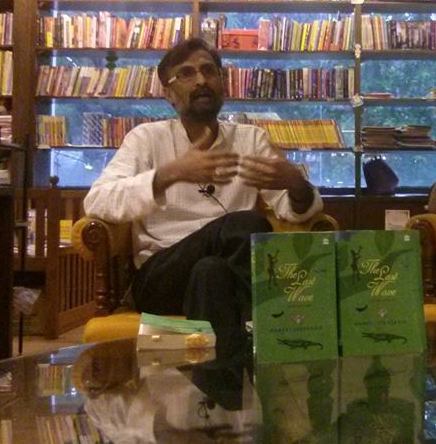
This has always been at the heart of the debate about the Jarawas and also the Andamans. Scientists have called the Andaman forests as one of the most pristine forests left on earth, untouched by human activity. Until two decades ago, the Jarawas were hostile to the settlers of the islands, not permitting anyone to enter their forests. Things changed after one encounter in late 1990s, that Sekhsaria wrote about for Frontline, when it first happened.
Sekhsaria has visited the island several times in the last 20 years, and the sub-plots of the novel, are various sides of the “interfaces” among the people, and between the people and the environment.
In the novel, researcher David finds a foreign photographer inside the reserve and loses his temper with the man, who is then forced to leave.
Read: I wrote a novel because I felt this was a story that needed to be told: Pankaj Sekhsaria
In his blog, lastwave, Sekhsaria reproduced this portion of the book with the introduction:
“The ongoing 'Organic Jarawa' documentary making saga has prompted many friends to write in pointing to the uncanny similarity between what's happening now and the episode in 'The Last Wave' involving the British photographer Michael Ross and before that, the French photographer, Henri...”
Read the relevant portion on at the following link http://pankaj-lastwave.blogspot.in/2014/10/two-intruders-in-last-wave.html
The News Minute | October 26, 2014 | 10.54 am IST
The question of how two French filmmakers ventured into the Jarawa Reserve to make a film, has uncanny parallels with a novel about the Andamans published in May this year.
French filmmaker Alexandre Dereims has been in and out of the reserve for three years, filming within the reserve into which entry is restricted. Following news reports about the film first by Andamanchronicle.net editor Denis Giles, the local administration has lodged cases against the filmmakes and has also sent them a notice restraining the release of the film.
 Read:
How did two French filmmakers enter restricted Jarawa territory, shoot a full-fledged movie?
Read:
How did two French filmmakers enter restricted Jarawa territory, shoot a full-fledged movie?
This incident, bears striking resemblance to one of the sub-plots in the novel The Last Wave, authored by journalist, researcher and photographer Pankaj Sekhsaria. Published in May, the novel is about the Andaman Islands and its people. The Jarawas are central to the novel. In an interview with The News Minute in August, Sekhsaria described his novel in these terms: “If you see in the novel, one never really enters the Jarawa forests. It’s a story about the fringes, about that interface (between the settlers and the Jarawas), the challenges that the cultures face. My attempt is that: What happens when these two cultures interface. I don’t go to either the Jarawas, or to the settlers, even though I know the settler world more.”

This has always been at the heart of the debate about the Jarawas and also the Andamans. Scientists have called the Andaman forests as one of the most pristine forests left on earth, untouched by human activity. Until two decades ago, the Jarawas were hostile to the settlers of the islands, not permitting anyone to enter their forests. Things changed after one encounter in late 1990s, that Sekhsaria wrote about for Frontline, when it first happened.
Sekhsaria has visited the island several times in the last 20 years, and the sub-plots of the novel, are various sides of the “interfaces” among the people, and between the people and the environment.
In the novel, researcher David finds a foreign photographer inside the reserve and loses his temper with the man, who is then forced to leave.
Read: I wrote a novel because I felt this was a story that needed to be told: Pankaj Sekhsaria
In his blog, lastwave, Sekhsaria reproduced this portion of the book with the introduction:
“The ongoing 'Organic Jarawa' documentary making saga has prompted many friends to write in pointing to the uncanny similarity between what's happening now and the episode in 'The Last Wave' involving the British photographer Michael Ross and before that, the French photographer, Henri...”
Read the relevant portion on at the following link http://pankaj-lastwave.blogspot.in/2014/10/two-intruders-in-last-wave.html
Published on October 26, 2014 06:22

